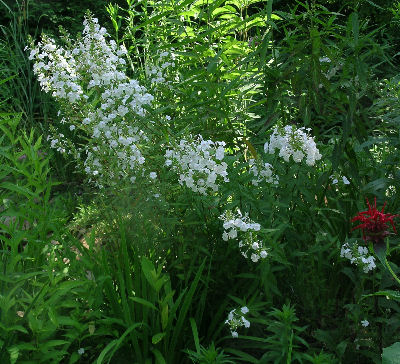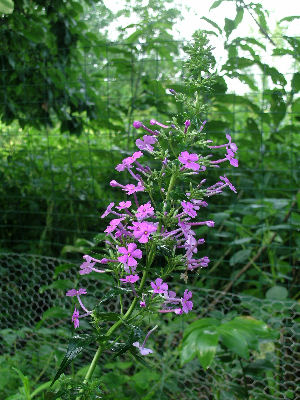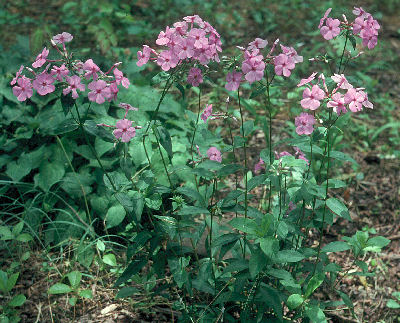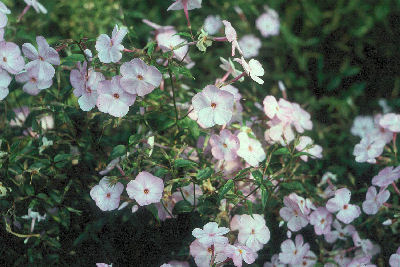In this section I will discuss the species and cultivars of Phlox primarily from a horticultural and natural history point of view. I am using genus section divisions that reflect that rather than strict taxonomy and listing species and cultivars alphabetically within each section for the sake of ease of reference. For botanical descriptions and keys see Wherry 1955 and other texts. In general the taxonomy follows the USDA Plants Database, except for P. ovata, which has recently been changed back from P. latifolia. There is excellent information on cultivation and propagation of the smaller phlox in Foster and Foster 1990.
Large Phlox
These
species seem to fall into two natural
groups, which I will call the paniculata-maculata group and
the ovata-pulchra group.Paniculata-Maculata Group
These species have foliage that in fall dies down completely or to short overwintering shoots (at least in USDA Zone 6 and north). Seed germination occurs within a year of sowing, sometimes without chilling. The cotyledons are noticeably narrower in proportion than in the next group. Seedlings usually bloom the first season. All chromosome counts I know of have been 2n=14, except for P. maculata 'Miss Lingard,' which is a triploid.
Phlox amplifolia (Large-leaf phlox) - Range: Southern Midwest, Indiana to Alabama, west to Missouri. Habitat: moist open woods and roadsides. Bloom time: late spring to early summer. Height: to about 150cm. Flower color: pink to purple. Bloom time: late spring to early summer. This species has not been used horticulturally and is related to P. paniculata, as evidenced by the presence of marginal veins in the leaves. In Tucker Co., northern West Virginia, there is a phlox that has been referred to as P. amplifolia in the West Virginia checklist and atlas but differs in that the leaves are wide-linear rather than rhomboidal, and the inflorescence lacks glandular pubescence. This blooms in early June and has pink-purple flowers.
Phlox carolina (Carolina phlox) - Range: North Carolina to southern Illinois and south to the Gulf of Mexico. Habitat: open woods and meadows. Height: from 45cm to about 200cm. Bloom time: spring to late summer. Flower color: pink to red-purple. The flowers are borne in loose, dome-shaped panicles. Current taxonomic treatments of P. carolina make it a variable species that includes widely differing forms. In practical terms it has been treated as a bin for forms that do not fit into the other species. Wherry recognized four subspecies that have widely overlapping ranges. Individual plants of all of these are described as having a few upright flowering shoots and rare sterile shoots.
P. c. subsp. carolina is described by Wherry as having "bright green" (ie yellow-green), relatively wide lanceolate leaves (10-30mm wide X 50-100mm long), and blooming late spring into summer. There is a confusing assemblage of forms that appear to belong to this taxon. All of these have lanceolate foliage on erect stems 60 to 90cm tall and bloom mid spring to mid summer. The plant growth habit varies from clump-forming to vigorously stoloniferous.
'Kim' - This is 45-60cm tall with light pink-purple flowers in irregular panicles. The plants are vigorously stoloniferous with many relatively lax sterile shoots. 'Kim' was found wild in Alabama and introduced by Jan Midgley.
'Lil' Cahaba' - Listed by Plant Delights Nursery from Bibb Co., Alabama, this is relatively slender and 60cm tall. It has "pinky-mauve" flowers in early to mid summer. It was collected by Jan Midgley along the Little Cahaba River.
'Minnie Pearl' - This beautiful selection was found in Kemper Co, east-central Mississippi. It has usually been considered a wild hybrid, but I think I will agree with Peter Zale at the OSU Germplasm Center that it is straight P. carolina. It is about 60cm tall and spreads to form a thick patch. There are masses of large white flowers for a long period from late spring into summer. I would rate 'Minnie Pearl' as the best early-blooming large phlox, since it has always thrived for me under adverse conditions in the garden and neglected in containers, always blooming well and free from mildew.
P. c. subsp. alta is limited to the southern Appalachians and has dark green foliage and blooms later, mid to late summer. The leaves are more rounded than those of ssp. carolina. Wherry describes this as "massive" and up to 200cm tall, but mine are about 100cm tall in bloom. This is the only P. carolina I have seen in nature. This was in the Blue Ridge of western North Carolina, where it grows most commonly along the Blue Ridge Parkway near Asheville at 4000 to 5000ft on roadside banks and in openings in well-drained acid soil, blooming in July and August. The plants are about 75 to 110cm tall and tend to have purplish stems. There are photos on a separate page. This is a very different habitat from those of P. g. ssp. glaberrima and P. glaberrima ssp. interior and P. maculata. My garden plants tend to have red-purple stem and new foliage coloration and form flower buds under cool greenhouse conditions in May, blooming from June until late summer.
P. carolina ssp. angusta of southern lowlands is small and wispy, with narrow (about 4mm maximum) leaves, and looks to me more closely related to P. glaberrima than P. carolina. My plants are the cultivar 'Gypsy Love' and bloom from late spring into summer. 'Gypsy Love' is a selection made by Gateway Gardens in Delaware that is 45-60cm tall and has red-purple flowers resembling those of typical P. glaberrima.
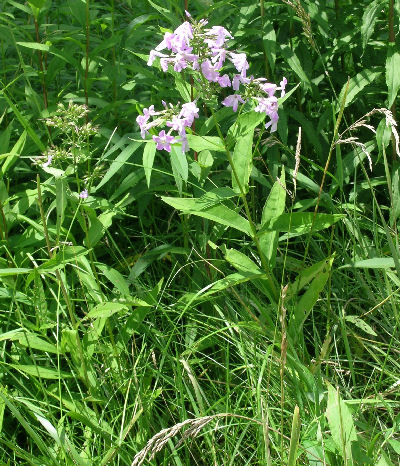 |
